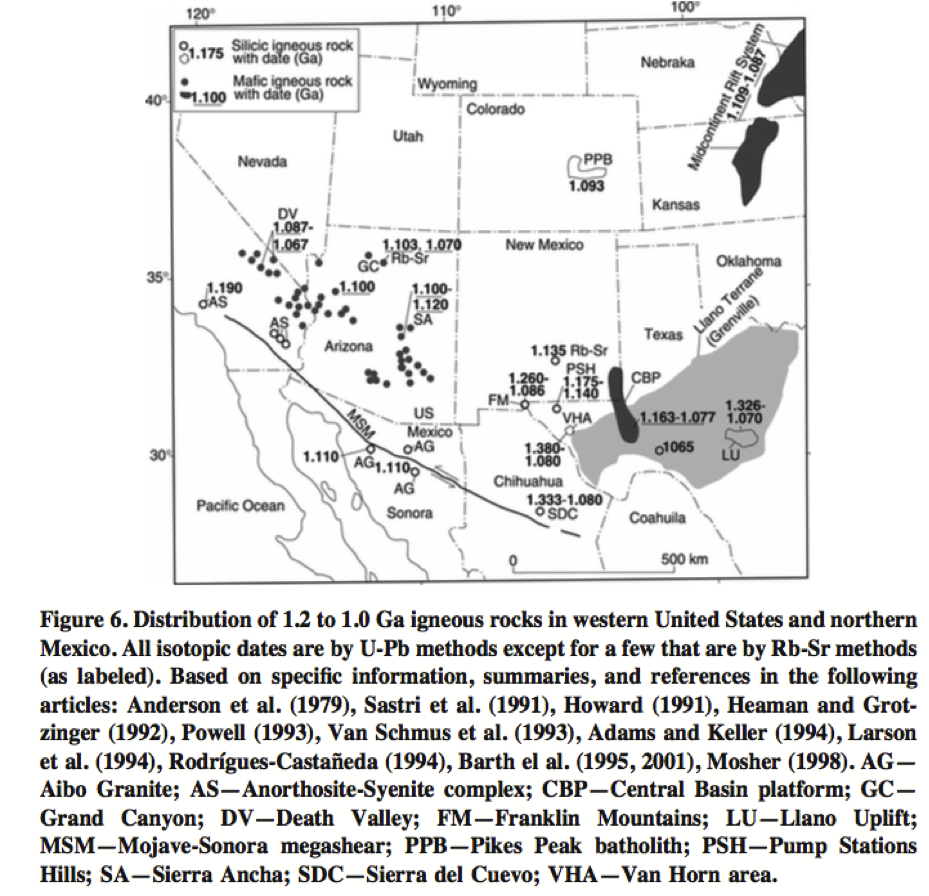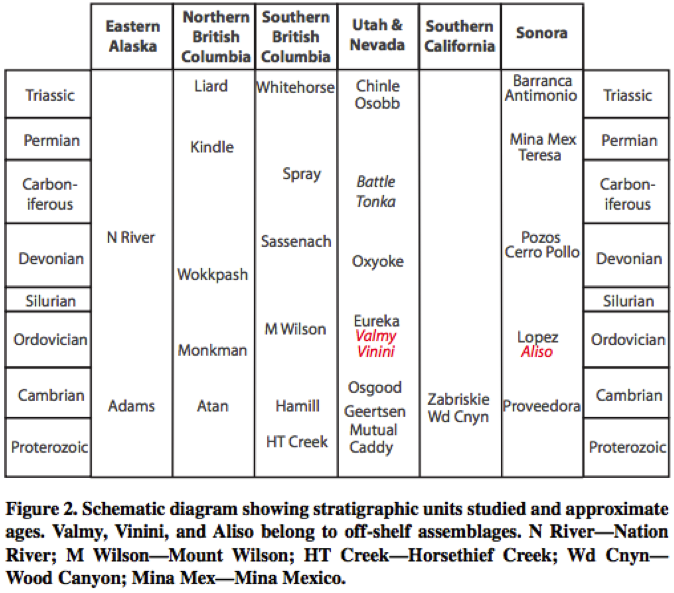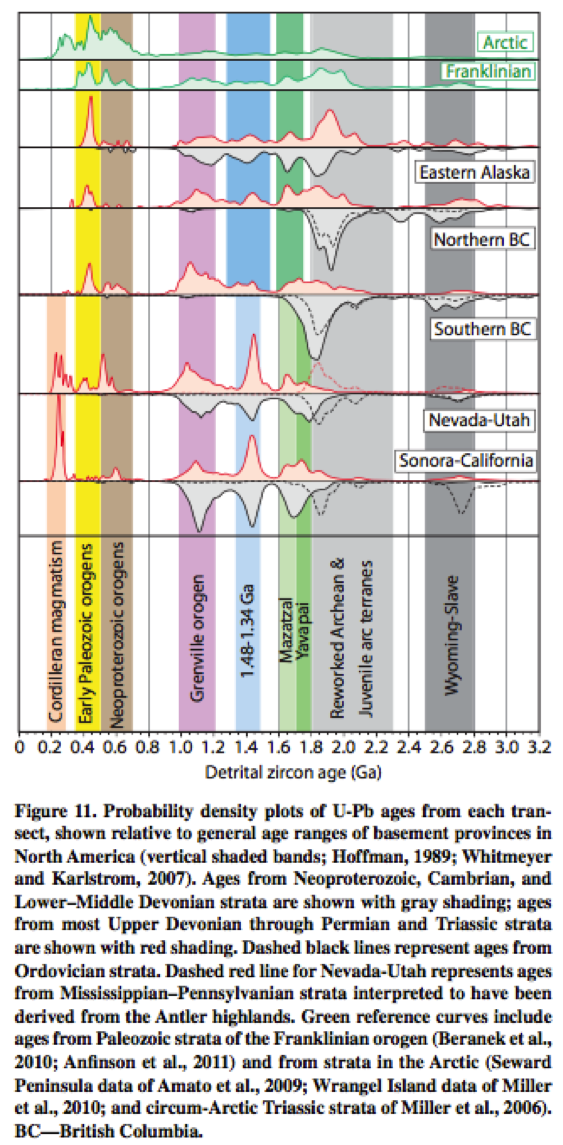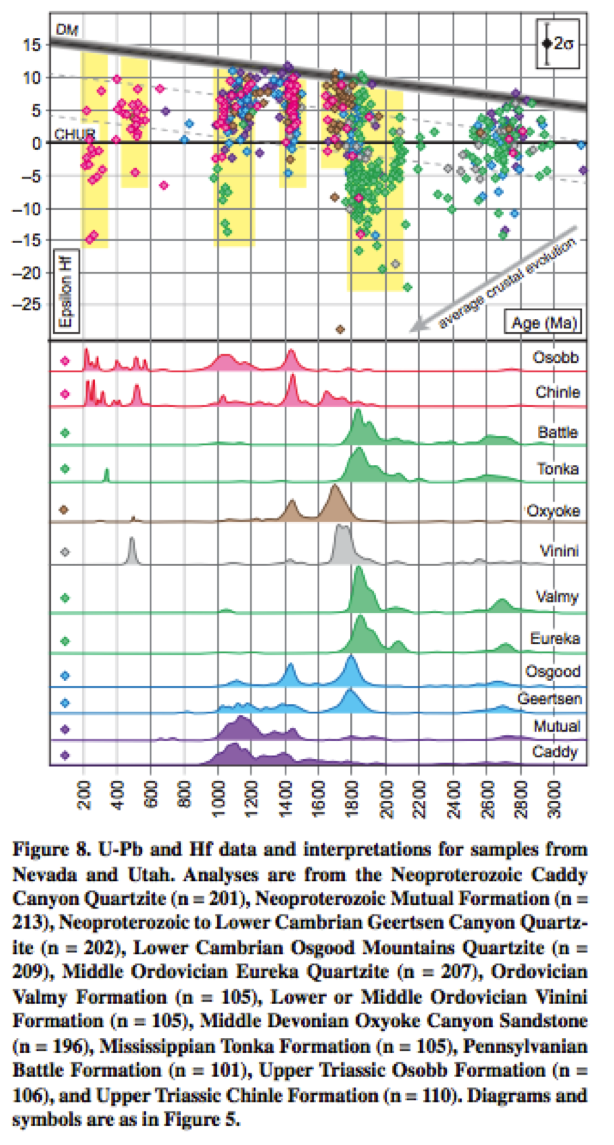
Figure 1. From Yonkee et al., (2014). This figure shows the locations potential cratonal sources for the miogeosyncline.

Rachel Havranek
IIn Hildebrand (2009) and Hildebrand (2013), the author proposes a novel mechanism by which the Phanerozoic tectonic history of the Western U.S. may be reinterpreted. Rather than the classical interpretation of a long lived eastward dipping subduction zone that controlled the tectonics inboard, Hildebrand proposes that North America collided with the ribbon continent “Rubia” during the Mesozoic era. This collision gave rise to the Sevier orogeny and subsequently the Laramide orogeny. This hypothesis postulates that the miogeoscline was allocthonous, and did not derive sediment from Laurentia. Particularly, Hildebrand considers the Pahrump Group, the Belt – Purcell Supergroup, Precambrian-Cambrian clastic and carbonate successions in Utah-Nevada (e.g. House, Deep Creek and Cricket Ranges) to be exotic. For this hypothesis to be valid, there cannot be sedimentary material in the miogeocline, or further west that was derived from the North American interior. To investigate this hypothesis, I will use detrital zircon studies to understand sediment provenance. With the advent of rapid and accurate U/Pb dating of zircon via LA-ICP-MS, detrital zircon studies have become precise tracers of sediment sources, assuming statistical significance (e.g. Anderson, 2005, Fedo et al., 2003). These studies can reveal information about plate configurations (e.g. Fedo et al., 2003) and tectonic dynamics (e.g. Jones et al., 2015). The purpose of this paper is to explore existing detrital zircon studies to determine if there is material from the North American interior making its way into Hildebrand’s Rubia, and more specifically, if sedimentary units are required to have been sourced from the North American interior.
A critical step for rigorously testing if sediment is required to have been sourced from North America is understanding the potential sources of zircon, and the suite of possible ages from on and off of Rubia. Yonkee et al. (2014) compiled a list of possible sources that includes (Figures 1 and 2):
Location |
Age of Zircons |
On or Off Rubia? |
Wyoming Province |
2.6- 3.0 Ga |
Off |
Grouse Creek Block |
2.5 – 2.6 Ga Leucogranite, 1.7 Ga overprinted metamorphic |
On |
Farmington Zone |
Distinctive 2.45 Ga, some inherited 1.7 – 2.7 Ga |
On |
Selway |
1.7 – 1.9 Ga |
On |
Great Falls zone |
1.9 |
Off |
Trans-Hudson zone |
1.8 – 2.1 Ga |
On |
Mojave Province |
1.7 – 1.9 Ga |
On |
Yavapai and Maztal provinces |
1.6 – 1.8 Ga |
Off |
Midcontinent magmatism |
1.3 – 1.5 Ga |
Off |
Grenville-Llano |
1.0 – 1.3 Ga (With a distinctive 1.1 Ga peak from the Southwest, including Death Valley) |
Both |
|
Figure 1. From Yonkee et al., (2014). This figure shows the locations potential cratonal sources for the miogeosyncline. |
 |
| Figure 2. From Bright et al., 2014. Emphasis on ~1.1 Ga localities in southern California added. |
These data dictate that zircons that with dates from 1.1 Ga, 1.7 – 2.1 Ga and 2.4 – 2.6 Ga may be derived from within Rubia, and as such are not indicative of a Laurentian source. Therefore, the zircons that are directly indicative of a North American source are limited to zircons that are older than 2.7 Ga (from the Wyoming Province), and 1.3 – 1.5 Ga (from midcontinent magmatism). Hildebrand argues that a 1.3 – 1.5 Ga peak is not necessarily indicative of a Laurentian source, because the sediment may have been derived from a rifted portion of North America (Hildebrand, 2009 p. 22). While I do not rule out this logic, it requires that there was a source of 1.3 – 1.5 Ga zircons in Rubia, that has subsequently been eroded or subducted away and therefore can neither be confirmed or negated definitively.
 |
Fig. 3. From Gehrels and Pecha (2014). Miogeoclinal strata for which they published DZ data | |
 |
Figure 4. From Gehrels and Pecha, 2014. Important to note in this figure is that there are peaks in Triassic through Neoproterozoic strata from the Wyoming Craton, that could not have been sourced from within Rubia. |
In a compilation of new and existing data, Gehrels and Pecha (2014) present detrital zircon data for 36 sample sites across the miogeocline (Figure 3). For all 6 major locations (e.g Southern B.C.), the authors identified a peak at or greater than 2.7 Ga (Figure 4). In the Nevada-Utah samples, most, but not all, of the samples contain zircons that date to >2.7 Ga (Figure 5). This would suggest zircons must be sourced from the cratonal interior of North America. In the Belt-Purcell group, which has an age of deposition of approximately 1.47 – 1.4 Ga, the lower units contain 1.6 – 1.5 Ga zircons, associated with the suturing of Australia or Antarctica to North America. The upper units cease to have 1.6-1.5 zircons, and have exclusively ~1.7 Ga zircons (Jones et al., 2015; Obrdaovich and Peterman, 1968). These data do not preclude the Belt-Purcell group being formed off of North America. In the Pahrump Group of Death Valley, only two units contain zircons that have a date > 2.7 Ga. This suggests that it is likely that the Pahrump group is not exotic to North America; however, all samples, except the Crystal Springs samples, contain dominant 1.4 Ga zircons. Without a Rubian source for 1.4 Ga grains, this confirms that the Pahrump group is associated with North America during the Mesoproterozoic and Neoproterozoic.
 |
Figure 5. From Gehrels and Pecha, 2014. Many, but not all, units from the Utah-Nevada section contain zircons associated with the Wyoming Craton. Many formations also have 1.4-1.5 Ga peaks, suggesting that they were sourced from the interior of North America. |
Hildebrand is correct in arguing that detrital zircon data should be treated with a healthy level of skepticism. The classic 1.7 Ga and 1.1 Ga signals that are attributed to the Yavapai province and Grenvillian uplifts, respectively, could be sourced from within a ribbon continent, and do not require connection with Laurentia. However, without the destruction of a 1.4 Ga source for Rubia, it is hard to explain a way in which the miogeocline is exotic based on the detrital zircon work alone. Therefore, I believe that it is unlikely that the miogeocline is exotic to North America.
References
Andersen, T., 2005. Detrital zircons as tracers of sedimentary provenance: limiting conditions from statistics and numerical simulation. Chemical Geology, 216(3), pp.249-270.
Bright, R.M., Amato, J.M., Denyszyn, S.W. and Ernst, R.E., 2014. U-Pb geochronology of 1.1 Ga diabase in the southwestern United States: Testing models for the origin of a post-Grenville large igneous province. Lithosphere, pp.L335-1.
Chapman, A.D., Ernst, W.G., Gottlieb, E., Powerman, V. and Metzger, E.P., 2015. Detrital zircon geochronology of Neoproterozoic–Lower Cambrian passive-margin strata of the White-Inyo Range, east-central California: Implications for the Mojave–Snow Lake fault hypothesis. Geological Society of America Bulletin, 127(7-8), pp.926-944.
Fedo, C.M., Sircombe, K.N. and Rainbird, R.H., 2003. Detrital zircon analysis of the sedimentary record. Reviews in Mineralogy and Geochemistry, 53(1), pp.277-303.
Gardner, D.W., Johnston, S.T. and Davis, W.J., 2008. Detrital zircon U–Pb provenance of the Upper Purcell Supergroup, Southeastern British Columbia, Canada: implications for the Belt-Purcell basin models and paleogeographic reconstructions. Geol. Soc. Am. Abs. Prog, 40, p.77.
Gehrels, G., 2011. Detrital zircon U‐Pb geochronology: Current methods and new opportunities. Tectonics of sedimentary basins: recent advances, pp.45-62.
Gehrels, George E., and William R. Dickinson. "Detrital zircon provenance of Cambrian to Triassic miogeoclinal and eugeoclinal strata in Nevada." American Journal of Science 295.1 (1995): 18-48.
Hildebrand, R.S., 2009. Did westward subduction cause Cretaceous–Tertiary orogeny in the North American Cordillera? Geological Society of America Special Papers, 457, pp.1-71.
Hildebrand, R.S., 2013. Mesozoic assembly of the North American cordillera(Vol. 495). Geological society of America.
Jones, J.V., Daniel, C.G. and Doe, M.F., 2015. Tectonic and sedimentary linkages between the Belt-Purcell basin and southwestern Laurentia during the Mesoproterozoic, ca. 1.60–1.40 Ga. Lithosphere, 7(4), pp.465-472.
Mahon, R.C., Dehler, C.M., Link, P.K., Karlstrom, K.E. and Gehrels, G.E., 2014. Detrital zircon provenance and paleogeography of the Pahrump Group and overlying strata, Death Valley, California. Precambrian Research, 251, pp.102-117.
Obradovich, J.D. and Peterman, Z.E., 1968. Geochronology of the Belt series, Montana. Canadian Journal of Earth Sciences, 5(3), pp.737-747.
Yonkee, W.A., Dehler, C.D., Link, P.K., Balgord, E.A., Keeley, J.A., Hayes, D.S., Wells, M.L., Fanning, C.M. and Johnston, S.M., 2014. Tectono-stratigraphic framework of Neoproterozoic to Cambrian strata, west-central US: Protracted rifting, glaciation, and evolution of the North American Cordilleran margin. Earth-Science Reviews, 136, pp.59-95.